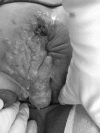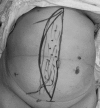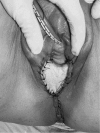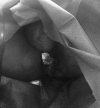So Now My Patient Has Squamous Cell Cancer: Diagnosis, Staging, and Treatment of Squamous Cell Carcinoma of the Anal Canal and Anal Margin
- PMID: 30397394
- PMCID: PMC6214805
- DOI: 10.1055/s-0038-1668105
So Now My Patient Has Squamous Cell Cancer: Diagnosis, Staging, and Treatment of Squamous Cell Carcinoma of the Anal Canal and Anal Margin
Abstract
Squamous cell carcinomas of the anal canal and the anal margin are rare malignancies that are increasing in incidence. Patients with these tumors often experience delayed treatment due to delay in diagnosis or misdiagnosis of the condition. Distinguishing between anal canal and anal margin tumors has implications for staging and treatment. Chemoradiation therapy is the mainstay of treatment for anal canal squamous cell, with abdominoperineal resection reserved for salvage treatment in cases of persistent or recurrent disease. Early anal margin squamous cell carcinoma can be treated with wide local excision, but more advanced tumors require a combination of chemoradiation therapy and surgical excision.
Keywords: abdominoperineal resection; anal squamous cell carcinoma; chemoradiation; wide local excision.
Figures







Similar articles
-
Local excision for patients with stage I anal canal squamous cell carcinoma can be curative.J Gastrointest Oncol. 2019 Apr;10(2):171-178. doi: 10.21037/jgo.2018.12.12. J Gastrointest Oncol. 2019. PMID: 31032082 Free PMC article.
-
Squamous Cell Carcinoma of the Anal Canal and Anal Margin.Aust N Z J Surg. 1972 May;38(4):301-305. doi: 10.1111/j.1445-2197.1972.tb05642.x. Aust N Z J Surg. 1972. PMID: 29265281
-
Endoanal ultrasound in the staging and management of squamous-cell carcinoma of the anal canal: potential implications of a new ultrasound staging system.Dis Colon Rectum. 2002 Jan;45(1):16-22. doi: 10.1007/s10350-004-6108-1. Dis Colon Rectum. 2002. PMID: 11786758 Clinical Trial.
-
Surgical management of anal cancer.Minerva Chir. 2015 Apr;70(2):141-5. Epub 2015 Feb 18. Minerva Chir. 2015. PMID: 25690347 Review.
-
Malignant tumors of the anal canal: the spectrum of disease, treatment, and outcomes.Cancer. 1999 Apr 15;85(8):1686-93. doi: 10.1002/(sici)1097-0142(19990415)85:8<1686::aid-cncr7>3.0.co;2-7. Cancer. 1999. PMID: 10223561 Review.
Cited by
-
Dramatic response to modified docetaxel, cisplatin, and fluorouracil chemotherapy after immunotherapy in a patient with refractory metastatic anal cancer.Clin Case Rep. 2019 Aug 6;7(9):1729-1734. doi: 10.1002/ccr3.2333. eCollection 2019 Sep. Clin Case Rep. 2019. PMID: 31534737 Free PMC article.
-
Anal Cancer with Mediastinal Lymph Node Metastasis.Gastrointest Tumors. 2021 Jun;8(3):134-137. doi: 10.1159/000514112. Epub 2021 Mar 8. Gastrointest Tumors. 2021. PMID: 34307312 Free PMC article.
-
From benign to malignant: unveiling invasive squamous cell carcinoma following resection of perianal condyloma acuminatum: a case report.J Surg Case Rep. 2024 Apr 26;2024(4):rjae266. doi: 10.1093/jscr/rjae266. eCollection 2024 Apr. J Surg Case Rep. 2024. PMID: 38681478 Free PMC article.
References
-
- Winburn G B. Anal carcinoma or “just hemorrhoids”? Am Surg. 2001;67(11):1048–1058. - PubMed
-
- Frisch M, Glimelius B, van den Brule A J et al.Sexually transmitted infection as a cause of anal cancer. N Engl J Med. 1997;337(19):1350–1358. - PubMed
-
- Frisch M, Biggar R J, Goedert J J. Human papillomavirus-associated cancers in patients with human immunodeficiency virus infection and acquired immunodeficiency syndrome. J Natl Cancer Inst. 2000;92(18):1500–1510. - PubMed
-
- Meeuwis K A, Melchers W J, Bouten H et al.Anogenital malignancies in women after renal transplantation over 40 years in a single center. Transplantation. 2012;93(09):914–922. - PubMed

